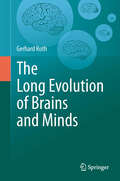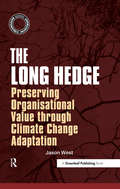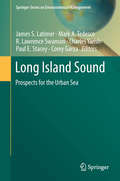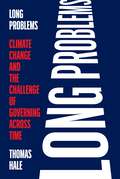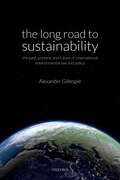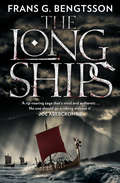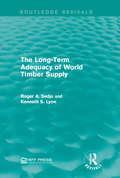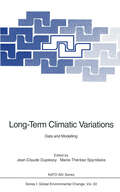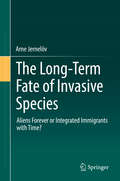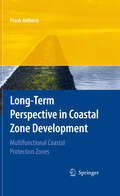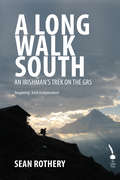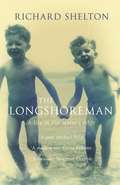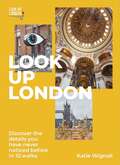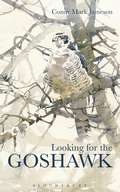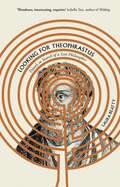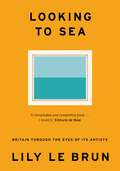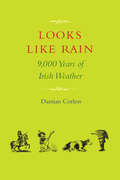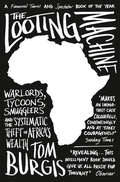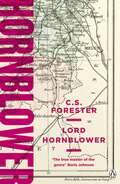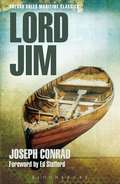- Table View
- List View
The Long Evolution of Brains and Minds
by Gerhard RothThe main topic of the book is a reconstruction of the evolution of nervous systems and brains as well as of mental-cognitive abilities, in short “intelligence” from simplest organisms to humans. It investigates to which extent the two are correlated. One central topic is the alleged uniqueness of the human brain and human intelligence and mind. It is discussed which neural features make certain animals and humans intelligent and creative: Is it absolute or relative brain size or the size of “intelligence centers” inside the brains, the number of nerve cells inside the brain in total or in such “intelligence centers” decisive for the degree of intelligence, of mind and eventually consciousness? And which are the driving forces behind these processes? Finally, it is asked what all this means for the classical problem of mind-brain relationship and for a naturalistic theory of mind.
The Long Hedge: Preserving Organisational Value through Climate Change Adaptation (The Responsible Investment Series)
by Jason WestPart of the Greenleaf Publishing Responsible Investment Series.Mitigating and adapting to risks and changing circumstances is a natural part of doing business. But methods of mitigating and adapting can be quite different in terms of time, cost and observed impacts. The impacts of mitigation activities are more immediate while the benefits of adaptation activities may take many years to take effect. Nowhere is this difference more apparent than in the case of the corporate response to climate change.In the context of climate change, adaptation is the process of changing behaviour in response to actual or expected climate change impacts. Climate change adaptation is now emerging as a critical partner to mitigation, and indeed may even become the primary protection mechanism for future generations.In this unique book, Jason West provides a comprehensive assessment of the management of climate change adaptation in the corporate sector. The book provides a formal overview of the range of approaches available along with a series of practical case studies and examples that can be used by companies and other organizations to identify, assess and manage climate change adaptation.A major focus is on the financial and investment implications of climate change adaptation. West examines how firms can evaluate the investment decisions associated with long-term climate change adaptation measures, including how such investments can be valued and funded, the appropriate accounting treatment of such measures and appropriate risk management and governance practices in relation to such measures. The book also considers the needs and interests of investors and other stakeholders, and considers how they can assess the adequacy and appropriateness of corporate action on climate change.The Long Hedge will be essential reading and a key text for risk-practitioners, investors, financiers, scholars and policy makers in the field of climate change.
The Long Hedge: Preserving Organisational Value through Climate Change Adaptation (The Responsible Investment Series)
by Jason WestPart of the Greenleaf Publishing Responsible Investment Series.Mitigating and adapting to risks and changing circumstances is a natural part of doing business. But methods of mitigating and adapting can be quite different in terms of time, cost and observed impacts. The impacts of mitigation activities are more immediate while the benefits of adaptation activities may take many years to take effect. Nowhere is this difference more apparent than in the case of the corporate response to climate change.In the context of climate change, adaptation is the process of changing behaviour in response to actual or expected climate change impacts. Climate change adaptation is now emerging as a critical partner to mitigation, and indeed may even become the primary protection mechanism for future generations.In this unique book, Jason West provides a comprehensive assessment of the management of climate change adaptation in the corporate sector. The book provides a formal overview of the range of approaches available along with a series of practical case studies and examples that can be used by companies and other organizations to identify, assess and manage climate change adaptation.A major focus is on the financial and investment implications of climate change adaptation. West examines how firms can evaluate the investment decisions associated with long-term climate change adaptation measures, including how such investments can be valued and funded, the appropriate accounting treatment of such measures and appropriate risk management and governance practices in relation to such measures. The book also considers the needs and interests of investors and other stakeholders, and considers how they can assess the adequacy and appropriateness of corporate action on climate change.The Long Hedge will be essential reading and a key text for risk-practitioners, investors, financiers, scholars and policy makers in the field of climate change.
Long Island Sound: Prospects for the Urban Sea (Springer Series on Environmental Management)
by James S. Latimer Mark A. Tedesco R. Lawrence Swanson Charles Yarish Paul E. Stacey Corey GarzaThe U.S. Ocean Commission Report identified the need for regional ecosystem assessments to support coastal and ocean management. These assessments must provide greater understanding of physical and biological dynamics than assessments at global and national scales can provide but transcend state and local interests. This need and timeliness is apparent for Long Island Sound, where a multi-state regional restoration program is underway for America’s most urbanized estuary. Synthesis of the Long Island Sound ecosystem is needed to integrate knowledge across disciplines and provide insight into understanding and managing pressing issues, such as non-point sources of pollution, coastal development, global climatic change, and invasive species. Currently, there is a need for a comprehensive volume that summarizes the ecological and environmental dynamics and status of Long Island Sound and its myriad ecosystems. It has been 30 years since a comprehensive summary of Long Island Sound was prepared and 50 years since the pioneering work of Gordon Riley. Major advances in estuarine science are providing new insights into these systems, and yet, the condition of many estuaries is in decline in the face of continuing coastal development. There is an opportunity to lay a foundation for integrative coastal observing systems that truly provide the foundation for improved decision-making. This book will provide a key reference of our scientific understanding for work performed over the past three decades and guide future research and monitoring in a dynamic urbanized estuary.
Long Problems: Climate Change and the Challenge of Governing across Time
by Thomas HalePolitical strategies for tackling climate change and other &“long problems&” that span generationsClimate change and its consequences unfold over many generations. Past emissions affect our climate today, just as our actions shape the climate of tomorrow, while the effects of global warming will last thousands of years. Yet the priorities of the present dominate our climate policy and the politics surrounding it. Even the social science that attempts to frame the problem does not theorize time effectively. In this pathbreaking book, Thomas Hale examines the politics of climate change and other &“long problems.&” He shows why we find it hard to act before a problem&’s effects are felt, why our future interests carry little weight in current debates, and why our institutions struggle to balance durability and adaptability. With long-term goals in mind, he outlines strategies for tilting the politics and policies of climate change toward better outcomes.Globalization &“widened&” political problems across national boundaries and changed our understanding of politics and governance. Hale argues that we must make a similar shift to understand the &“lengthening&” of problems across time. He describes tools and strategies that can, under certain conditions, allow policymakers to anticipate future needs and risks, make interventions that get ahead of problems, shift time horizons, adapt to changing circumstances, and set forward-looking goals that endure. As the climate changes, politics must, too. Efforts to solve long-term problems—not only climate change but other issues as well, including technology governance and demographic shifts—can also be a catalyst for a broader institutional transformation oriented toward the long term. With Long Problems, Hale offers an essential guide to governing across time.
The Long Road to Sustainability: The Past, Present, and Future of International Environmental Law and Policy
by Alexander GillespieFor the last few thousand years, humanity has struggled to achieve sustainable development. Gillespie sees the problem as multi-faceted: a three legged stool of economic, social, and environmental conundrums have stalled the quest for the long term viability of both our species and the ecosystems in which we reside. Gillespie moves from the low life expectancy, excessive deforestation, and wetland drainage of the medieval period, through the species loss, coal burning, free trade, and poor waste management of the seventeenth and eighteenth centuries, and to the more recent concerns of climate change, unsustainable fisheries, and chemical pollutants. By delivering a comprehensive examination of human survival over the past millennium, Gillespie illustrates that the challenges we face are not new - that we now have the means to counter them, is.
The Long Road to Sustainability: The Past, Present, and Future of International Environmental Law and Policy
by Alexander GillespieFor the last few thousand years, humanity has struggled to achieve sustainable development. Gillespie sees the problem as multi-faceted: a three legged stool of economic, social, and environmental conundrums have stalled the quest for the long term viability of both our species and the ecosystems in which we reside. Gillespie moves from the low life expectancy, excessive deforestation, and wetland drainage of the medieval period, through the species loss, coal burning, free trade, and poor waste management of the seventeenth and eighteenth centuries, and to the more recent concerns of climate change, unsustainable fisheries, and chemical pollutants. By delivering a comprehensive examination of human survival over the past millennium, Gillespie illustrates that the challenges we face are not new - that we now have the means to counter them, is.
The Long Ships: A Saga Of The Viking Age
by Frans G. BengtssonThis saga brings alive the world of the 10th century AD when the Vikings raided the coasts of England.
The Long-Term Adequacy of World Timber Supply (Routledge Revivals)
by Roger A. Sedjo Kenneth S. LyonProjecting modest future growth for both prices and harvest levels, this study, first published in 1990, provides theoretical and empirical justification for challenging the conventional wisdom that real timber prices will rise for the indefinite future. The study presents fifty-year projections of regional and world harvest levels, world market price, and investments in forest regeneration by region. This book will be of particular interest to students of economics and environmental studies.
The Long-Term Adequacy of World Timber Supply (Routledge Revivals)
by Roger A. Sedjo Kenneth S. LyonProjecting modest future growth for both prices and harvest levels, this study, first published in 1990, provides theoretical and empirical justification for challenging the conventional wisdom that real timber prices will rise for the indefinite future. The study presents fifty-year projections of regional and world harvest levels, world market price, and investments in forest regeneration by region. This book will be of particular interest to students of economics and environmental studies.
Long-Term Climatic Variations: Data and Modelling (Nato ASI Subseries I: #22)
by Marie-Thérèse Spyridakis Jean-Claude DuplessyClimate is the most important component of the Earth's environment and climatic fluctuations have a strong impact on water supplies, vegetation, energy use etc. Thus our understanding of the climatic system is of utmost importance. Leading experts in the field of climate modelling and paleoclimatology present the most recent methods for reconstructing past climatic variations and for modelling the climatic system and its evolution. The first of three parts is devoted to the climatic system and the physical basis for its modelling; the second summarizes the evolution of the global atmosphere, the ocean, the continents, the biosphere, and the ice sheets during recent climatic cycles; the last part focusses on the understanding of past and future climatic changes.
The Long-Term Fate of Invasive Species: Aliens Forever or Integrated Immigrants with Time?
by Arne JernelövThis book examines the long-term fate of invasive species by detailing examples of invaders from different zoological and botanical taxa from various places around the world. Readers will discover what happened, after a century or so, to 'classical' invaders like rabbits in Australia, house sparrows in North America, minks in Europe and water hyacinths in Africa and Asia. Chapters presented in the book focus on eighteen species in the form of in-depth case studies including: earthworms, zebra mussels, Canadian water weed, Himalayan balsam, house sparrows, rabbits, crayfish plague, Colorado beetles, water hyacinths, starlings, Argentine ant, Dutch elm disease, American mink, cane toad, raccoons, Canadian beavers, African killer bees and warty comb jelly. Invaded areas described are in Africa, Asia, Australia, Europe, North America, Pacific islands, and South America. Readers will get some ideas about the likely future of current invaders from the fate of old ones. This book is intended for undergraduates studying environmental sciences, researchers and members of environmental NGO's.
Long-Term Field Studies of Primates
by Peter M. Kappeler and David P. WattsSome primate field studies have been on-going for decades, covering significant portions of individual life cycles or even multiple generations. In this volume, leading field workers report on the history and infrastructure of their projects in Madagascar, Africa, Asia and South America. More importantly, they provide summaries of their long-term research efforts on primate behaviour, ecology and life history, highlighting insights that were only possible because of the long-term nature of the study. The chapters of this volume collectively outline the many scientific reasons for studying primate behaviour, ecology and demography over multiple generations. This kind of research is typically necessitated by the relatively slow life histories of primates. Moreover, a complete understanding of social organization and behaviour, factors often influenced by rare but important events, requires long-term data collection. Finally, long-term field projects are also becoming increasingly important foci of local conservation activities.
Long-term Perspective in Coastal Zone Development: Multifunctional Coastal Protection Zones
by Frank AhlhornFrom February 2004 until December 2007 the ComCoast project (Combined Fu- tions in Coastal Defence Zones) was carried out within the Interreg IIIB framework. The objective of this project was to investigate and to test the options for spatial coastal protection concepts. The mission statement of the project over its entire duration was: A wider approach in coastal thinking. I was glad to be part of this project and would like to thank all my European colleagues for the constructive and cooperative atmosphere. Firstly, I would like to express my thanks to Prof. Dr. Horst Sterr and Prof. Dr. Hans Kunz who assisted me over these years with their thorough guidance and comprehensive expertise and for many in-depth discussions on the focus of this dissertation. Secondly, I would like to thank my colleague Dr. Jur ¨ gen Meyerdirks, who acted as my key scienti c sparring partner over the last two years, and who continuously demonstrated his ability to bring me back to earth. Additionally, I would like to thank my colleague Dr. Thomas Klenke, who gave me the chance to be part of a challenging European project consortium and who supported me with his expertise on the project and the dissertation. Furthermore, I would like to express my special thanks to Gerard McGovern, who thoroughly improved my English.
A Long Walk South: An Irishman's Trek On The Gr5
by Sean RotheryPatronising advice by a doctor at a retirement course to ‘walk a couple of miles a day’ challenges architect Sean Rothery to take a proper walk and so, at the age of sixty-five, he sets out to walk the GR5, the Grande Randonée Cinq. From the steely grey North Sea to the intense blue Mediterranean, Sean’s 2,300km-long route follows a network of old trails, forest paths, canal banks, Alpine valleys and passes. Along the way, he recounts some of his youthful enterprises, including cycling from Dieppe to Rome in the ruins of post-war Europe and a climbing accident in 1967 that saw him challenge another doctor’s prognosis. Ghosts of the past are revisited, most poignantly in the Alps where two friends died in climbing accidents, but also alongside the ruins of First World War trenches. Sketchbook in hand, Sean savours the landscape, history and culture as he passes from one country to another. Every day he looks out for the distinctive red-and-white waymarks of the GR5 – not an easy task, especially when change in the name of progress has cleared swathes of trails. This enthralling diary of a long walk south will have the reader urging the author on to the last step of the way.
The Longleaf Pine Ecosystem: Ecology, Silviculture, and Restoration (Springer Series on Environmental Management)
by Shibu Jose Eric J. Jokela Deborah L. MillerThis book unites a wealth of current information on the ecology, silviculture and restoration of the Longleaf Pine ecosystem. The book includes a discussion of the significant historical, social and political aspects of ecosystem management, making it a valuable resource for students, land managers, ecologists, private landowners, government agencies, consultants and the forest products industry.
The Longshoreman: A Life At The Water's Edge
by Richard Shelton'When I first urged Richard Shelton to write his naturalist's memoir, I never expected him to produce a classic. But he has.' Redmond O'Hanlon, author of Trawler Fish have been a lifelong obsession for Richard Shelton. As a boy in the 1940s, he was fascinated by what he found in the streams near his Buckinghamshire home. But it was the sea and the creatures living in it and by it which were to become his passion. The Longshoreman follows the author from stream to river, from pond to lake and loch, from shore to deep sea, on a journey from childhood to an adulthood spent in boats in conditions fair and foul. Along the way, this wonderful book introduces us to strange characters and the intimate habits of lobsters; it also explains what it's like to be a lantern fish; how some fish commute between the surface and the darkest depths, when the laws of physics say they should be crushed to death; and the fate of the wild salmon, that heroic fish whose future is now imperilled by its farmed relatives. A keen fisherman and wildfowler, and an authority on marine life, Shelton has deeply held views on our relationship with the natural world, and Britain's with the seas which surround her.
Look Up London: Discover the details you have never noticed before in 10 walks
by Katie WignallA refreshing guide to discovering the hidden details of London with 10 fully guided walking routes from London's leading tour guide Look Up London. Have you ever noticed London's tiniest public sculpture? Or wondered why there are strange cone-shaped structures on the fanciest historic homes? Did you know that the Tower of London used to be a zoo, or about the now defunct London railway that transported over 200,000 people to their final resting place? These are just some of the fascinating details that Blue Badge Tourist guide Katie Wignall reveals in this absorbing guide to the secrets of London hidden in plain sight. Take a journey through London's rich past with these 10 fully guided walking routes and discover a whole world of incredible history hiding above your eye-line, just waiting to be spotted. From the saucy scandals of Covent Garden to stories of power and intrigue from the City, atmospheric pubs to hidden Roman remains, London is a city bursting with captivating stories which are etched into its very architecture. So, Look Up and discover a London you have never seen before.
Looking for the Goshawk (Bloomsbury Nature Writing Ser.)
by Conor Mark JamesonThe book traces Conor Jameson's travels in search of the Goshawk, a magnificent yet rarely seen (in Britain at least) raptor. Each episode of the narrative arises from personal experience, investigation, and the unearthing ofinformation from research, exploration and conversations.The journey takes him from an encounter with a stuffed Goshawk in a glass case, through travels into supposed Goshawk territories in Britain, to Berlin - where he finds the bird at ease in the city. Why, he wants to know, is the bird so rarely seen in Britain? He explores the politics of birdwatching, the sport of falconry and the impact of persecution on the recent history of the bird in Britain and travels the length of Britain, through central Europe and the USA in search of answers to the goshawk mystery. Throughout his journey he is inspired by the writings of T H White who told of his attempts to tame a Goshawk in his much-loved book.It's a gripping tale on the trail of a most mysterious and charismatic bird.
Looking for Theophrastus: Travels in Search of a Lost Philosopher
by Laura BeattyWho is Theophrastus, and why should we care?Once, he was the equal of Plato and Aristotle. Together he and Aristotle invented science. Alone he invented Botany. The character of the Wife of Bath is his invention, the Canterbury Tales as a whole, perhaps, the product of his inspiration. When Linnaeus was developing our modern system of plant taxonomy, it was Theophrastus' work on plants that he used as a basis. So how could one man do so much and still sink almost without a trace?This is the story of a journey to find him and bring him back from oblivion. Looking for Theophrastus, in all the places he must have walked and lived, it tells how he and Aristotle, his friend and tutor, broke with the philosophical conventions of the Academy and left on their own adventure; of how together they invented what we now take for granted as the Natural Sciences; how, not content with that, they made the great experiment of applying philosophy directly to the practicalities of government through the tutoring of Alexander the Great; how they were disappointed and how, in the end, they returned to Athens and founded the famous Lyceum.Against the dramatic context of his time - the end of democracy in Athens and the rise of Alexander the Great; the great battles and vast territorial expansion that followed; the flowering of the philosophy schools on which so much of our culture and thinking is founded - and on, following his cultural legacy through to the modern day, it explores how we perceive, understand and, most importantly, how we relate to the world around us, questioning what we lose from our way of living when we forget those ancients who first taught us how to see.
Looking to Sea: Britain Through the Eyes of its Artists
by Lily Le Brun*One of The Times Best Art Books of the Year*'Looking to Sea is a remarkable and compelling book... I loved it.' Edmund de Waal'In her first, transporting book, Lily Le Brun sweeps the beaches of the past century of British art, collecting treasures from sea, shingle and shore... A book to pack in your picnic basket for shivering dips, heatwave day trips and ice-cream Sundays' The TimesAn alternative history of modern Britain, Looking to Sea is an exquisite work of cultural, artistic and philosophical storytelling. Looking to Sea considers ten pivotal artworks, from Vanessa Bell's Studland Beach, one of the first modernist paintings in Britain, to Paul Nash's work bearing the scars of his experience in the trenches and Martin Parr's photographs of seaside resorts in the 1980s, which raised controversial questions of class. Each of the startlingly different pieces, created between 1912 and 2015, opens a window onto big ideas, from modernism and the sublime, the impact of the world wars and colonialism, to issues crucial to our world today like the environment and nationhood. In this astonishingly perceptive portrait of the twentieth century, art critic Lily Le Brun brings a fresh eye to a vast idea, offering readers an imaginative new way of seeing our island nation.'Le Brun's writing is at once bold and delicate, far-reaching and fine-tuned. Her book explores the inexhaustible variety of human perception.' Alexandra Harris'A smart and clear-eyed set of meditations on marine gaze, made with a painterly touch worthy of the chosen artists. Empathy and intelligence lift memoir into cultural history.' Iain Sinclair'Elegant and endlessly interesting . . . as much a rich compendium of social history as it is a hard consideration of art itself' Critic
Looks Like Rain: 9,000 Years Of Irish Weather
by Damian CorlessThe name the Romans gave to Ireland was Hibernia, which means ‘Land of Winter’, and cold feet may have been a factor in their decision to leave the Irish to their own devices. The weather is our main topic of conversation and has done its bit in shaping our character. This lively overview shines a light on incidents when the weather – generally bad – changed the course of Ireland’s history. Along the way it takes in those years – and there were quite a few – when the sun really didn’t shine. We learn how Oliver Cromwell, invincible in war, most likely caught his death from a Cork mosquito. The Irish climate created the heavy soil that made the potato flourish in Ireland like nowhere else, with disastrous consequences. David Lean came to Ireland fully intending to give the County Kerry weather a starring role in his film Ryan’s Daughter. He didn’t make another film for fourteen years. Our professional forecasters still hedge their bets by predicting four seasons in one day – and still often get it laughably wrong. But there are sunny stories too, such as how, in 1973, the brooding Antrim weather produced one of rock music’s greatest album covers, and how the Irish legend of the crock of gold at the rainbow’s end came about. Remarkably, Ireland’s weather has remained the same moderate mixed blessing since the Romans left.
The Looting Machine: Warlords, Tycoons, Smugglers And The Systematic Theft Of Africa's Wealth
by Tom BurgisOverseas Press Club Award Winner 2016 A shocking investigative journey into the way the resource trade wreaks havoc on Africa, ‘The Looting Machine’ explores the dark underbelly of the global economy.
Lord Hornblower: Flying Colours, The Commodore, Lord Hornblower, Hornblower In The West Indies (A Horatio Hornblower Tale of the Sea #10)
by C. S. Forester1813, and Horatio Hornblower is propelled toward the heart of the French Empire and his old enemy, Napoleon . . . Sir Horatio Hornblower has received strict and highly confidential orders from the highest rank: he must embark upon a grave and perilous mission to recapture the Flame in the Bay of Seine, where the brutal and foul-tempered Lieutenant Augustine Chadwick is being held prisoner by a mutinous crew. Rescuing the Lieutenant demands all of Horatio’s spirit and seafaring prowess – for at the same time, he must contend with capturing two French cargo vessels and take part in negotiations to topple the faltering Napoleon once and for all . . . This is the ninth of eleven books chronicling the adventures of C.S. Forester’s inimitable nautical hero, Horatio Hornblower.
Lord Jim: A Romance (Adlard Coles Maritime Classics)
by Joseph ConradJim is young, ambitious and idealistic, keen to make his name in the world. But fate has other plans. Jim has been made First Mate on board the Patna, but when the she starts to flood in the middle of the voyage, Jim joins the captain and crew in abandoning the ship and her passengers to their fate. The ship survives, but Jim is stripped of his rank for dereliction of duty, and realises how far short he has fallen of his dreams of becoming a leader and a hero.The narrative, voiced by sea captain Charles Marlow (also the narrator of Conrad's Heart of Darkness), follows Jim as he tries to redeem himself. As he travels ever further eastwards, Jim ends up on a remote Indonesian island where his name and reputation mean nothing. Finally it seems that he can start afresh, and after defeating a local bandit he wins the admiration of the local people (and a beautiful girl), and becomes their leader: 'Lord Jim'. However, his past is always there... Partly based on true events, this is a compelling and vivid story, and Conrad's telling of it asks us to judge for ourselves what we think of Jim. This beautifully-produced classic edition also includes a Foreword by explorer and Discovery Channel star Ed Stafford (the first man to walk the length of the Amazon river) and a reading guide.
